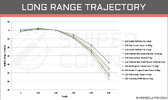The Glockodile
Member
- Joined
- May 6, 2020
- Messages
- 1,688

Well, lookit this here fancy graph.
Seems sumptin’ like validation for the 50 - yard “combat zero.”
1. Assume having one nice autoloading rifle in .223 Remington, which you shoot paper effectively out to say, 500 meters.
2. You have multiple bullet weights which you handload for - 53, 55, 62, 69, and 77 grains, which all seem to shoot accurately.
3. You shoot each handload equally.
4. You have been twiddling with your scope and resetting its zero far too often for each different handload.
I imagine the amount of elevation available and reticle type would come into play, but for the sake of simplicity let’s say these weren‘t an issue.
Ignoring the minimal deviation of impact from point of aim to impact between 0 and 200 yards, to what round would you zero your scope for and be more or less comfortable using holds beyond 200 yards?
Would you zero the rifle for:
1. … the lightest / fastest bullet and aim high for the heavier / slower bullets, or…
2. …the heaviest / slowest bullet and aim low for the lighter / faster bullets, or…
3. …find some middle ground, aiming high or low depending on the load?
This is a “jack of all trades zero” kind of question. Not a load development thread.
EDIT: A little more context - roughly 30,000 bullets of each weight has been hoarded over the years.
Last edited:

